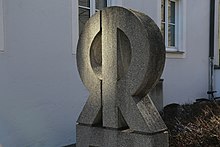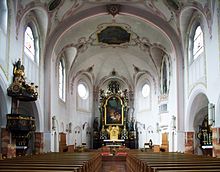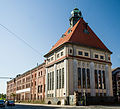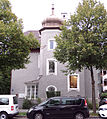Franz Rank
Franz Rank (born April 7, 1870 in Munich ; † December 27, 1949 ) was a German architect and building contractor . During his almost fifty years of creativity he created over 250 works (projects and completed works added together). These include numerous apartment buildings and villas, commercial buildings, inns, schools, hospitals and churches. Ranks' houses are predominantly art nouveau , while his church buildings were all built in the neo-baroque style.
Life
The father Josef Rank was the owner of a small construction business in Munich- Schwabing . After attending the construction school in Munich, Franz Rank worked as a construction technician in Bregenz in 1889 . He continued his technical training in Augsburg in 1890 . After further stations in Cologne and Hanover , he went to study at the Technical University of Munich in 1892 , where he studied primarily with Friedrich von Thiersch . Martin Dülfer was of particular importance to Rank at this time . In 1893 he was looking for employees for perspective depictions of the Frankfurt clarifier cleaning and the spring water pipe. The collaboration with Dülfer lasted almost five years.
In 1899, Franz Rank went into business for himself. Together with his brothers Josef Rank (1868–1956) and Ludwig Rank (1873–1932), he took over the family business, which from then on operated as the Gebrüder Rank construction company. The young company quickly paved the way for new stylistic trends.
In addition to the construction of residential and commercial buildings, schools, hospitals and churches, technical and industrial structures such as bridges , brewery buildings, water towers , airport structures, gas and electricity plants and silo structures were a specialty of the company.
In the course of the division of tasks in the joint company, Ludwig Rank built up his own branch of the company in Spain. In the Munich office, Josef Rank was responsible for technical development. Franz Rank was responsible for the artistic designs and represented the artistic head of the company.
The Rank Brothers construction company soon became known. Their often significant structural innovations such as the use of reinforced concrete were regularly presented in the trade press. Many of the buildings they carried out were in the public eye because of their function. B. the entrance area to the Munich trade fair .
Franz Rank designed some palace buildings for particularly wealthy families, including Mainberg Palace near Schweinfurt for the industrialist Ernst Sachs. The work also includes less prominent building projects such as B. the extensive multi-family residential building development on the corner property Daiserstraße / Oberländerstraße in Munich- Sendling from 1901.
Important church buildings were built according to designs by Franz Rank in Au near Berchtesgaden , in Munich- Solln , in Bad Griesbach near Passau , in Munich- Großhadern and in Lindenberg in the Allgäu . In Kirchham near Passau he led the reconstruction of the baroque church that had burned down.
Work (selection)
Churches
- 1902–1906: Parish Church of St. Johann Baptist in Munich-Solln
- 1907–1908: Parish Church of the Holy Family in the Berchtesgaden district of Oberau
- 1910–1912: City Parish Church of the Holy Family in Bad Griesbach im Rottal , Haagstraße 35 (under monument protection)
- 1912–1914: Parish Church of St. Peter and Paul in Lindenberg im Allgäu , Goethestraße 3 (under monument protection)
- 1914–1915: Reconstruction of the burned down baroque parish church of St. Martin in Kirchham near Passau, Kirchplatz 4 (under monument protection)
- 1925–1926: St. Canisius parish church in Munich- Großhadern
Secular buildings
- 1898, Kleinvilla Knorrstraße 12, Milbertshofen, Munich. Two-storey hipped roof building in historicizing forms with partially boarded-up gable, staircase tower with dome roof and plaster structure, by Josef Rank
- 1902–1903: Water tower in the Kirchseeon sleeper works (under monument protection)
- 1904: Interior fittings for the reception room of the district president in the presidential building of the government of Upper Franconia in Bayreuth
- 1904/1907: Gasthof Rabenwirt in Pullach in the Isar Valley (under monument protection)
- 1905: Former local history museum, now a carving school, Bergwerkstrasse 12, Berchtesgaden
- 1906–1907: New school building for the state secondary school in Würzburg
- 1907–1908 and 1912–1913: Office building of the book printing and publishing house Carl Gerber in Munich, Angertorstrasse 2 (under monument protection)
- 1907–1908 gymnasium of the men's gymnastics club in Munich from 1879 (listed)
- 1908: Gate structures on the exhibition grounds in Munich
- 1909: Administration building of the Gebrüder Röchling company in Munich, Hansastraße 21 (called Sander Villa since around 1970, used by the ADAC since 2012)
- 1909: Commercial building, Rosenstrasse 6 (the Schuster sports store opened there in 1913 ; today Rosen Apotheke)
- 1910–1911: Lindwurmhof office and commercial building in Munich, Lindwurmstrasse 88
- 1908–1909 / 1911: Factory buildings of the wagon factory Josef Rathgeber AG in Munich-Moosach , Untermenzinger Straße 1 (under monument protection)
- 1911: Brewhouse of the Johann Humbser brewery in Fürth, Schwabacher Strasse 106 / Fichtenstrasse (under monument protection)
- 1911–1912: Third Order Hospital in Munich
- 1911–1912: New buildings for the Graeflich von Moy'sches Hofbrauhaus in Freising
- 1912–1915: Gas works in Augsburg
- 1915–1916: Double water tower in the railroad workers' settlement at the Hohenbudberg marshalling yard in Duisburg-Friemersheim
- 1917–1919: hangars of the former Berlin-Friedrichsfelde aviation station
- 1925: Renovations in Mainberg Castle near Schweinfurt
- 1941: Riesenfeldstrasse bunker
- Boarding schools run by the English Misses in Simbach, Krumbach , Augsburg, Mallersdorf and Munich-Nymphenburg
- Multi-family housing development Daiserstraße / Oberländerstraße in Munich-Sendling
- Passion play theater in Oberammergau
- New construction of the stage wing of the Festspielhaus in Bayreuth
literature
- Dieter Klein: The Rank brothers. Architecture between Historicism and Heimatstil . In: More beautiful homeland, heritage and mission , ISSN 0931-7864 , 77. Born in 1988, H. 3rd
Web links
- Project overview from Gebr. Rank at www.industrie-kultur.de , accessed on June 20, 2010
- Company history of the construction company Gebrüder Rank GmbH & Co. , last accessed on July 29, 2014
Individual evidence
- ↑ Life data after entry of Franz Rank in the historical register of architects archthek , accessed on June 20, 2010 / January 1, 2018
- ^ List of architectural monuments in Pullach
- ↑ school chronicle siebold-gymnasium.de
- ↑ Würzburg today: magazine for culture and economy, issues 55–58, p. 49 [1]
- ↑ cf. List of architectural monuments in Munich's old town
- ↑ List of architectural monuments in the Isarvorstadt (Munich)
- ↑ cf. List of architectural monuments in Moosach (Munich)
- ^ Wolfgang Schneider: Locations. From the airship hangar to the garden city. Kulturring in Berlin eV, Berlin 2015, p. 47ff.
| personal data | |
|---|---|
| SURNAME | Rank, Franz |
| BRIEF DESCRIPTION | German architect and contractor |
| DATE OF BIRTH | April 7, 1870 |
| PLACE OF BIRTH | Munich |
| DATE OF DEATH | December 27, 1949 |

















